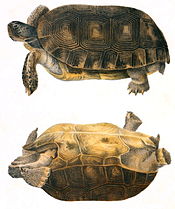- Razor-backed musk turtle
-
Razor-backed musk turtle 
Scientific classification Kingdom: Animalia Phylum: Chordata Class: Sauropsida Order: Testudines Family: Kinosternidae Genus: Sternotherus Species: S. carinatus Binomial name Sternotherus carinatus
(Gray, 1856)Synonyms Aromochelys carinata Gray, 1856
Ozotheca triquetra Agassiz, 1857
Goniochelys triquetra - Agassiz, 1857
Goniochelys carinata - Garman, 1884
Cinosternum carinatum - Boulenger, 1889
Kinosternon carinatum - Stejneger & Barbour, 1917
Sternothaerus carinatus - Tinkle, 1958[1]The razor-backed musk turtle (Sternotherus carinatus) is a species of turtle native to the United States.
Contents
Geographic range
It is found in the states of Oklahoma, Arkansas, Mississippi, Texas, Florida and Louisiana.
Description
The razor-backed musk turtle grows to approximately 15 cm (5.9 in) in length. It has a brown-colored shell, with black markings at the edges of each scute. The shell has a distinct, sharp keel down the center of its length, giving the species its common name. The body is typically grey-brown in color, with black spotting, as is the head, which tends to have a bulbous shape to it. It has a long neck, short legs, and a sharp beak. Males can usually be distinguished from females by their longer tails.
Behavior
They are almost entirely aquatic, spending most of their time in shallow, heavily vegetated, slow-moving creeks, or ponds. The only time they typically venture onto land is when females lay their eggs. When a razor-backed musk turtle feels threatened, it will release a foul odor, similar to a skunk's.
Diet
Their diet consists primarily of aquatic invertebrates, including freshwater clams, crayfish, snails, and various insects. They also feed on fish and carrion.
In captivity
The razor-backed musk turtle is frequently found in captivity, and is regularly captive bred. Its relatively small size, and ease of care makes it a more attractive choice as a pet turtle for many keepers, than the more commonly available red-eared slider (Trachemys scripta elegans).
References
- ^ Fritz, Uwe and Peter Havaš. 2007. Checklist of the Chelonians of the World. Museum für Tierkunde. Dresden.
Kinosternidae family of turtles Genus Species of the Kinosterninae subfamilyKinosternon Alamos mud turtle · Arizona mud turtle · Central American mud turtle · Creaser's mud turtle · Dunn's mud turtle · Durango mud turtle · Eastern mud turtle · Herrara's mud turtle · Jalisco mud turtle · Mexican mud turtle · Mexican plateau mud turtle · Oaxaca mud turtle · Scorpion mud turtle · Sonora mud turtle · Striped mud turtle · Tabasco mud turtle · White-lipped mud turtle · Yellow mud turtleSternotherus Genus Species of the Staurotypinae subfamilyClaudius Staurotypus Phylogenetic arrangement of turtles based on turtles of the world 2010 update: annotated checklist of taxonomy, synonymy, distribution and conservation status.Order Testudines (turtles) Suborder SuperfamilySubfamily
Cryptodira Chelydra · MacrochelysCaretta · Chelonia · Eretmochelys · Lepidochelys · NatatorDermochelysDermatemydidaeDermatemysStaurotypinaeClaudius · StaurotypusBatagur · Cuora · Cyclemys · Geoclemys · Geoemyda · Hardella · Heosemys · Leucocephalon · Malayemys · Mauremys · Melanochelys · Morenia · Notochelys · Orlitia · Pangshura · Rhinoclemmys · Sacalia · Siebenrockiella · VijayachelysAldabrachelys · Astrochelys · Chelonoidis · Chersina · Cylindraspis · Geochelone · Gopherus · Homopus · Indotestudo · Kinixys · Malacochersus · Manouria · Psammobates · Pyxis · Stigmochelys · TestudoTrionychiaCarettochelyidaeCarettochelysTrionychinaePleurodira ChelidinaeChelodininaeHydromedusinaePelomedusa · PelusiosPhylogenetic arrangement based on turtles of the world 2010 update: annotated checklist. Extinct turtles not included.
See also List of Testudines families
 Portal ·
Portal ·  WikiProjectCategories:
WikiProjectCategories:- Sternotherus
- Animals described in 1855
- Reptiles of the United States
- Fauna of the Southeastern United States
- Fauna of the Plains-Midwest (United States)
Wikimedia Foundation. 2010.
